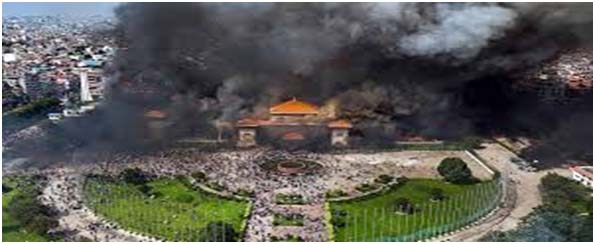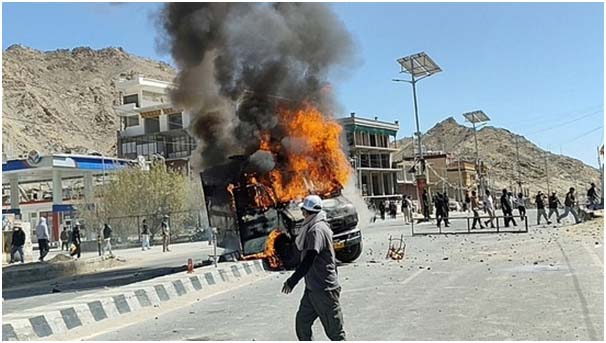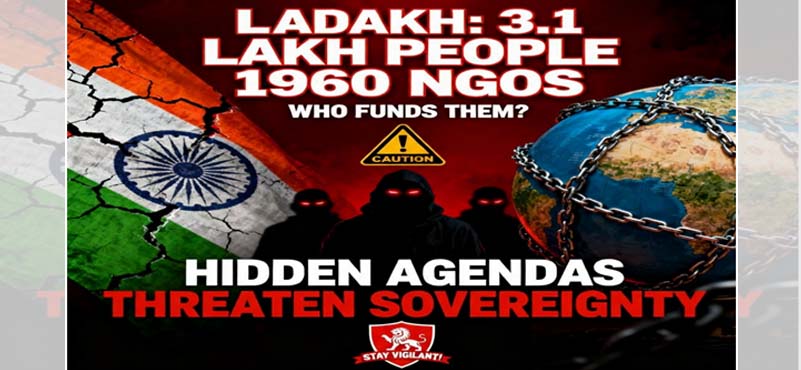Ladakh is not just a major tourist attraction. It is one of India’s most fragile and strategic frontiers. With a population of barely 3.1 lakh, it is hemmed in by China on one side and Pakistan on the other, which have seen both adversaries’ attempts to threaten India’s sovereignty. In such a sensitive borderland, the presence of nearly 1,960 NGOs is both surprising and worrying. Many of these groups provide genuine services in healthcare, education, and environmental protection. Yet the sheer density of organisations in a sparsely populated frontier raises an unavoidable question: who funds them and for what purpose? This does not inspire blind trust, especially when the global trend of foreign-funded NGO’s being part of a toolkit to steer narratives and fuel rebellion is a reality. The pattern is consistent, and it provides a sobering backdrop to Ladakh’s reality.
Global Misuse of NGOs
Across the world, NGOs have doubled as instruments of foreign power. Georgia, Ukraine and Kyrgyzstan saw “colour revolutions” steered by networks of donor-backed organisations. These were sold as people’s uprisings, but they carried the stamp of foreign cash and training. These were not purely organic revolts but engineered shifts, enabled by organisations that had the cover of civic activism.
Russia’s response was instructive. In 2012, it introduced the foreign agent law, compelling any NGO receiving money from abroad and engaged in political activity to register as a foreign agent. The law was condemned internationally, yet Moscow defended it as an act of sovereignty. Hungary, too, confronted NGOs linked to George Soros’ foundations, accusing them of interfering in domestic policy on migration and weakening the state. China has been even more blunt, banning Foreign NGO’s in regions such as Xinjiang and Tibet. The Chinese state leaves no room for ambiguity when stability and sovereignty are at stake. Even the United States, which champions civic freedoms, runs a strict disclosure regime through its Foreign Agents Registration Act. Any organisation funded by outsiders to influence domestic policy must disclose its donors and activities. Transparency is non-negotiable in Washington, yet India often shies away from similar firmness.
Lessons from the Neighbourhood
South Asia offers closer lessons. Nepal’s regime change in 2025 did not happen in isolation. Activist groups, student unions, and media bodies funded from outside were central in shaping the streets. Bangladesh in 2024 saw a similar pattern: NGOs amplified charges of repression, built lobbying abroad and bent the political contest. Sri Lanka has long accused humanitarian NGOs of running parallel political lines. Myanmar’s democratic stirrings were supported and sustained by foreign advocacy groups.

While the idea of democracy itself is not contested, the fact remains that such activism was deeply enmeshed with external strategic agendas. What looks like civic action is often the soft end of geopolitical power.
India’s Own Experience
India is not untouched. The protests against the Kudankulam nuclear plant in Tamil Nadu were investigated by the government and found to have been fuelled by NGOs receiving foreign funds. Money meant for social development was diverted into anti-nuclear protests.
The farmers’ agitation in 2020–21 was the clearest reminder of how NGO-style activism can be weaponised. What began as opposition to new farm laws was soon magnified into a global campaign. The toolkit controversy exposed transnational involvement in shaping the protests, with foreign-based advocacy groups providing both digital muscle and narrative spin. Local grievances were projected as evidence of democratic backsliding, creating pressure not only on the government but also on India’s international image.
The Northeast has also seen the hand of NGOs in protests, many of them linked to church groups and international rights organisations. These groups raised indigenous and separatist issues abroad, giving insurgent voices legitimacy on foreign platforms. What begins as civil society action at home often becomes a tool for lobbying against India overseas.
Technology as a Catalyst
The threat is magnified by technology. Earlier, an NGO’s influence was limited to pamphlets, protests, or petitions. Today, the digital domain has transformed them into global actors. Social media platforms, encrypted chat groups, and slick video campaigns allow even small NGOs to amplify grievances overnight. A hashtag seeded in one corner of the world can trend globally within hours. During the farmers’ protests, narratives created abroad went viral online before ground reports were even verified. Edited videos, deepfakes, and selective framing became tools of disinformation. In a frontier like Ladakh, NGOs with access to external patrons could easily use these platforms to magnify grievances into separatist tones. The digital ecosystem has become the new battlefield of narrative warfare.
Why Ladakh is Different
Ladakh magnifies these concerns. Its strategic location between two hostile neighbours makes it a theatre of contestation not just for military power but also for ideas and loyalties. NGOs in Ladakh interact with monasteries, youth, masses, and local councils. In a demographically fragile region, narratives seeded by outsiders can have a disproportionate impact. A story about environmental neglect or cultural alienation can be turned into a movement questioning India’s presence itself. When such narratives gain traction, amplified by social media, they become as dangerous as any weapon.

The Foreign Contribution Regulation Act already governs foreign funding to NGOs in India. Thousands of registrations have been cancelled for violations. Yet loopholes remain. Many organisations continue to operate without full disclosure of donors and without audited accounts. In Ladakh, such gaps are not just administrative failings but potential national security threats.
India’s Weak Spot
India remains hesitant in confronting this challenge. The state too often handicaps itself with the pretence of fairness. India has a regulatory law, the FCRA, and thousands of NGO registrations have been cancelled. India knows that foreign-backed NGOs are exploited by adversaries, yet the system struggles to take decisive action. Shell entities find backdoors through trusts and digital transfers. Oversight is often patchy. Unlike Russia or China, India hesitates to act. That hesitation is read as weakness. Adversaries exploit it. At the working levels, adopting a ‘blind man’ approach, fear of being sidelined, and petty politics are some flaws in the system.
The Road Ahead
The world has already shown how soft power can be turned into regime change. From Ukraine to Nepal, from Myanmar to Bangladesh, NGOs and advocacy groups have carried hidden hands of influence. India cannot be naïve. But transparency cannot be optional. Every NGO in Ladakh must be registered with the Union Territory administration. Their funding sources and accounts must be made fully public. Foreign-funded groups should face periodic audits by joint teams of administration, finance, and security agencies. Social media activity linked to NGOs must be monitored for narrative manipulation.
At the same time, legitimate grievances in Ladakh must not be ignored. If there are issues of development, environmental stress, or cultural concern, the government must address them directly. Leaving space for external actors to exploit local discontent is a recipe for instability.
India needs a pan-India audit of all NGOs. The time for an ostrich approach or hesitancy is over. Democracy must remain vibrant, grievances must be addressed, but sovereignty must not be compromised under the garb of tolerance. Transparency, accountability, and vigilance are the deterrence to avert another catastrophe. It’s time the PMO and NSA step in to remove these anti-national shadows in Ladakh’s civic landscape.
ABOUT THE AUTHOR
 Lieutenant General A B Shivane, is the former Strike Corps Commander and Director General of Mechanised Forces. As a scholar warrior, he has authored over 200 publications on national security and matters defence, besides four books and is an internationally renowned keynote speaker. The General was a Consultant to the Ministry of Defence (Ordnance Factory Board) post-superannuation. He was the Distinguished Fellow and held COAS Chair of Excellence at the Centre for Land Warfare Studies 2021 2022. He is also the Senior Advisor Board Member to several organisations and Think Tanks.
Lieutenant General A B Shivane, is the former Strike Corps Commander and Director General of Mechanised Forces. As a scholar warrior, he has authored over 200 publications on national security and matters defence, besides four books and is an internationally renowned keynote speaker. The General was a Consultant to the Ministry of Defence (Ordnance Factory Board) post-superannuation. He was the Distinguished Fellow and held COAS Chair of Excellence at the Centre for Land Warfare Studies 2021 2022. He is also the Senior Advisor Board Member to several organisations and Think Tanks.








